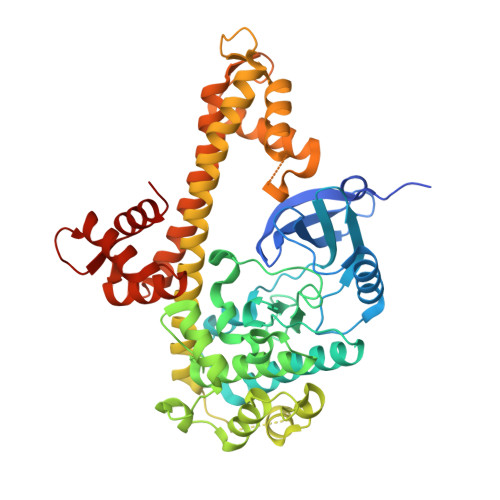Multiple determinants for selective inhibition of apicomplexan calcium-dependent protein kinase CDPK1.
Larson, E.T., Ojo, K.K., Murphy, R.C., Johnson, S.M., Zhang, Z., Kim, J.E., Leibly, D.J., Fox, A.M., Reid, M.C., Dale, E.J., Perera, B.G., Kim, J., Hewitt, S.N., Hol, W.G., Verlinde, C.L., Fan, E., Van Voorhis, W.C., Maly, D.J., Merritt, E.A.(2012) J Med Chem 55: 2803-2810
- PubMed: 22369268
- DOI: https://doi.org/10.1021/jm201725v
- Primary Citation of Related Structures:
3SX9, 3SXF, 3T3U, 3T3V, 3UPX, 3UPZ, 3UQF, 3UQG, 3V51, 3V5P, 3V5T - PubMed Abstract:
Diseases caused by the apicomplexan protozoans Toxoplasma gondii and Cryptosporidium parvum are a major health concern. The life cycle of these parasites is regulated by a family of calcium-dependent protein kinases (CDPKs) that have no direct homologues in the human host. Fortuitously, CDPK1 from both parasites contains a rare glycine gatekeeper residue adjacent to the ATP-binding pocket. This has allowed creation of a series of C3-substituted pyrazolopyrimidine compounds that are potent inhibitors selective for CDPK1 over a panel of human kinases. Here we demonstrate that selectivity is further enhanced by modification of the scaffold at the C1 position. The explanation for this unexpected result is provided by crystal structures of the inhibitors bound to CDPK1 and the human kinase c-SRC. Furthermore, the insight gained from these studies was applied to transform an alternative ATP-competitive scaffold lacking potency and selectivity for CDPK1 into a low nanomolar inhibitor of this enzyme with no activity against SRC.
Organizational Affiliation:
Department of Biochemistry, University of Washington, Seattle, Washington, United States.















